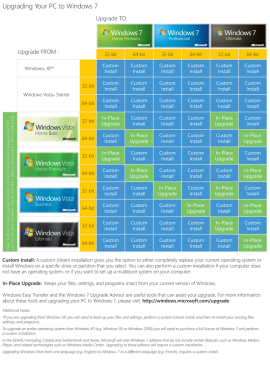Microsoft blunders with a confusing Windows 7 upgrade chart

Someone at Microsoft is secretly working for Apple.
That’s the only possible explanation I can come up with for why they sent this “Official Windows 7 Upgrade chart” to Walt Mossberg of the Wall Street Journal, who published it in full with surprisingly little commentary.
Even in a thumbnail version, the chart tells a horrifying story: Upgrading to Windows 7 will be hideously complex. You might as well just throw up your hands now. Here, see for yourself. The blue boxes are for custom (clean) installs; the green boxes mean you can do an in-place upgrade:
So what’s wrong with this chart? In a word, everything.
First, it includes one entire row dedicated to a product that doesn’t exist: Windows Vista Starter 64-bit edition (Vista Starter is available in 32-bit only). In fact, the entire row for Vista Starter shouldn’t be there, given that it is only offered for sale on very low cost PCs in developing nations and is not sold in the U.S., Western Europe, Australia, Japan, and the rest of the developed world. (In a Twitter exchange, Mossberg confused Vista Starter with Windows 7 Starter and assumed that the former is sold on netbooks. It isn’t.)
Second, of the 66 separate options listed, many are completely ludicrous. Is anyone going to “upgrade” from 64-bit Vista Business to 32-bit Windows 7 Home Premium? Half of those blue boxes are there to simply make the point that you can’t do an in-place upgrade from 32-bit to 64-bit Windows or vice versa.
Look, most customers considering an upgrade will be running one of a handful of Windows products. If they are using Windows XP, they’ll need to do a custom install to move up to Windows 7. That was announced ages ago; would-be upgraders have another two or three months to get their program disks together so they can do the upgrade when the time comes. Most Vista users will have clear and logical upgrade paths from their current edition to the same edition of Windows 7.
It took me about an hour to redo this horrible chart into something that is both accurate and useful. It faithfully includes every option listed in the Microsoft chart, with the errors corrected. Click the thumbnail below to see it in its full-size glory:
Which one do you find more readable?
One option I list in this chart is worth calling out specifically, because I haven’t seen anyone else mention it. Officially, you can’t do an in-place upgrade from Windows Vista Home Basic or Home Premium to Windows 7 Professional. However, there’s a fairly simple workaround: Do an in-place upgrade from your Vista Home edition to Windows 7 Home Premium, then use Windows Anytime Upgrade to move up to Professional edition. Based on published prices, the extra cost is a mere $10. The Professional upgrade is $200; the Home Premium upgrade followed by a Professional upgrade is $120+$90, or $210. Using this strategy, you can keep all your installed programs and not have to worry about reinstalling and transferring data.
